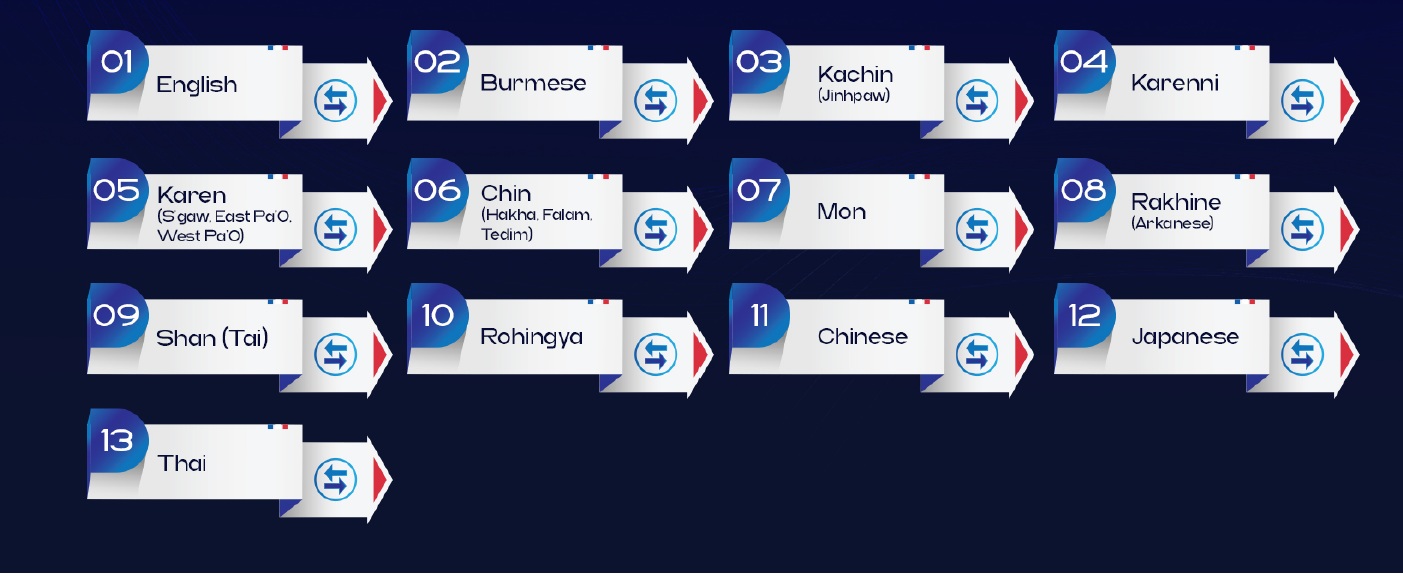Our Clients

Language

The Jingpo people, also known as Kachin in Myanmar, are an ethnic group primarily living in northern Myanmar and Yunnan Province in China. They speak the Jingpo language. Historically, the Jingpo were animists, worshipping nature spirits and ancestors, but over time, many have converted to Christianity, especially in Myanmar, where Christian missionaries have influenced the community. The Jingpo people are predominantly agricultural, with rice being their staple crop, and their way of life is closely tied to the land they cultivate.
The Karenni people, also known as the Kayah, primarily reside in Kayah State in eastern Myanmar, with some communities also found in northern Thailand. They speak the Kayah languages, which belong to the Sino-Tibetan language family, and their cultural identity is strongly tied to their linguistic heritage and traditions. The Karenni practice a mix of animism and Christianity, with many holding onto their traditional beliefs in spirits and nature alongside the influence of Christian missionaries. Despite facing political challenges and displacement, the Karenni continue to preserve their cultural heritage and customs in the face of modern pressures.
The S'gaw Karen are a prominent subgroup of the Karen people, predominantly residing in Karen State in Myanmar and in various regions of Thailand. They speak the S'gaw Karen language, which belongs to the Sino-Tibetan language family, reflecting their rich linguistic heritage. The S'gaw Karen community is characterized by a diverse spiritual landscape; while many adhere to Buddhism and Christianity, a significant number still practice animism. Despite political and economic pressures, the S'gaw Karen continue to thrive, fostering a spirit of resilience and community solidarity.
The Pa'O people, one of Myanmar's many ethnic groups, are traditionally divided into two main groups: The East Pa'O, primarily residing in Shan State, and the West Pa'O, found in Kayah and Karen States. Both groups share the Pa'O language, which belongs to the Tibeto-Burman family, though slight dialectical variations exist between the two. The East Pa'O, who live closer to urban areas such as Taunggyi, are more exposed to modern influences, resulting in a lifestyle that blends traditional customs with contemporary developments. Their unity is reflected in cultural celebrations, traditional clothing, and shared historical narratives, which continue to bind the East and West Pa'O together as one people, regardless of the influence of modernity or geographical separation.
The Burmese people, also known as the Bamar, are the largest ethnic group in Myanmar, and their influence shapes much of the country’s culture and identity. The Burmese language, part of the Sino-Tibetan language family, is the official language of Myanmar and is spoken by the majority of the population. The Burmese are widely known for their hospitality and generosity, often expressed through acts of sharing food and welcoming guests into their homes. Despite the challenges Myanmar has faced over the years, the Burmese people take great pride in their rich cultural heritage, maintaining their traditions while adapting to modern developments.

The Falam Chin are an ethnic group native to Falam, a town in the mountainous Chin State of Myanmar. They speak the Falam Chin language, which is part of the broader Tibeto-Burman language family. While Christianity is the predominant religion among the Falam Chin, reflecting the influence of missionary activities during the colonial era, some still practice traditional animism. Despite their geographic isolation, the Falam Chin maintain a strong sense of community, and their social life revolves around communal activities and traditional festivals.
The Tedim Chin are an ethnic group native to the town of Tedim in Chin State, Myanmar. They speak the Tedim language, which is part of the Kuki-Chin branch of the Tibeto-Burman language family, and their linguistic heritage is a key aspect of their identity. The majority of the Tedim Chin people are Christian, predominantly Baptists. Despite modern influences and economic challenges, the Tedim Chin work to preserve their traditions, language, and sense of identity while adapting to the evolving world around them.
The Hakha Chin are an ethnic group native to the town of Hakha, the capital of Chin State in Myanmar. They speak the Hakha language, which belongs to the Kuki-Chin branch of the Tibeto-Burman language family, and language plays a significant role in preserving their cultural identity. The majority of Hakha Chin are Christian, with most identifying as Baptists. Despite modern challenges, the Hakha Chin remain resilient in preserving their language, customs, and agricultural traditions, ensuring their rich cultural legacy endures.
The Mon people, an ethnic group in Myanmar, primarily reside in Mon State, although smaller communities can be found throughout the country and in parts of Thailand. They speak the Mon language, which belongs to the Mon-Khmer branch of the Austroasiatic language family, and are predominantly Theravada Buddhists, with a minority practicing traditional animism. Despite the challenges of maintaining their language and traditions, the Mon continue to uphold their cultural identity with pride.
The Rakhine people, also known as the Arakanese, are an ethnic group native to Rakhine State in western Myanmar. They speak the Rakhine language, which is closely related to Burmese but retains unique linguistic features that set it apart. Historically, Rakhine State has been a cultural crossroads, influenced by Indian, Burmese, and Southeast Asian civilizations, which is evident in the state’s architecture, art, and historical monuments. Despite modern challenges, the Rakhine people maintain a strong sense of cultural identity and regional pride, preserving their traditions while adapting to contemporary changes.
The Shan people, an ethnic group primarily residing in Shan State in eastern Myanmar, are an integral part of the country’s diverse cultural landscape. They speak the Shan language, which belongs to the Tai-Kadai language family and shares linguistic similarities with other Tai languages spoken across Southeast Asia. The Shan people are part of the broader Tai ethnic group, often referred to as Tai Long or Tai Yai, sharing deep linguistic, cultural, and historical connections with other Tai groups in neighboring countries like Thailand, Laos, and southern China. Their rich cultural heritage, shaped by centuries of history and interaction with neighboring regions, remains a source of pride for the Shan people as they continue to uphold their traditions in the modern world.


